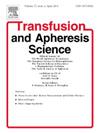GRAIN 研究--粒细胞抗感染--造血干细胞移植中粒细胞输注的应用
IF 1.4
4区 医学
Q4 HEMATOLOGY
引用次数: 0
摘要
粒细胞输注(GTx)可防治中性粒细胞减少患者的感染。然而,移植环境中免疫介导的脱靶效应尚不清楚。在 2020 年 1 月至 2021 年 12 月期间,对所有在移植围手术期使用过 GTx 的移植手术进行了分析。从临床记录中检索了移植、感染和清除天数。将总存活率与平均 PMN 总计数和不同产品进行比较。110名患者(98%)使用了集合水包衣,其中38名患者(34%)还使用了无细胞产品。GTx天数的中位数为4天,用于制备单个水包衣产品的集合袋数的中位数为4袋。每个集合水包衣的平均PMN总数为0.98×1010/L粒细胞,每个无细胞产品的平均PMN总数为1.93×1010/L粒细胞。48%的人使用集合水包衣获得了较高的 PMN 数量(1 × 1010/L),而 85% 的人使用无细胞血浆获得了较高的 PMN 数量。接受 GTx 治疗的患者中有 39% 出现呼吸恶化。所有接受粒细胞移植的患者中,中性粒细胞移植的中位时间为 14 天,血小板移植的中位时间为 20 天。81%的患者血液培养物清除,而只有 28%的患者其他培养物清除。真菌性肺炎治愈率为 25%,侵袭性真菌性鼻窦炎或中耳炎治愈率为 50%。总体存活率为 47%,PMN 剂量越高,存活率越高(57% 对 39%,P = 0.1),但无显著性差异。就有效的 PMN 剂量而言,汇集缓冲衣是一种经济实惠的无细胞疗法替代方法。在围移植期,集合水包衣易于获得且成本低廉,总体存活率相当,这表明它是一种安全有效的产品。本文章由计算机程序翻译,如有差异,请以英文原文为准。
GRAIN Study - Granulocytes Against Infections - Use of granulocyte transfusion in haematopoietic stem cell transplant
Granulocyte transfusions (GTx) combat infections in neutropenic patients. However, immune-mediated off-target effects in transplant settings are unknown. Between January 2020 and December 2021, all transplants that used GTx during the peri-transplant period were analysed. Engraftment, infections, and days to clearance were retrieved from clinical records. Overall survival is compared with the mean total PMN count and the different products. Pooled buffy coat was used in 110 patients (98 %), of which 38 (34 %) additionally received an apheresed product. The median days of GTx was 4. The median bags pooled to prepare a single buffy coat product was 4. The mean total PMN count was 0.98 × 1010/ L granulocytes per pooled buffy coat and 1.93 × 1010/L granulocytes per apheresis product. A higher PMN count (>1 × 1010/L) was achieved in 48 % with pooled buffy coat versus 85 % with apheresis. Respiratory worsening occurred in 39 % receiving GTx. All patients who received granulocytes had engrafted with a median time of 14 days for neutrophil and 20 days for platelet engraftment. Blood cultures cleared in 81 %, whereas only 28 % cleared other cultures. Fungal pneumonia cleared in 25 %, and invasive fungal sinusitis or otitis cleared in 50 %. Overall survival was 47 %, non-significantly higher (57 % vs 39 %, P = 0.1) with a higher PMN dose. The pooled buffy coat is an affordable alternative to apheresis for an effective PMN dose. Ease of availability and low cost of pooled buffy coat, with comparable overall survival points toward a safe and efficacious product, in the peri-transplant period.
求助全文
通过发布文献求助,成功后即可免费获取论文全文。
去求助
来源期刊
CiteScore
3.60
自引率
5.30%
发文量
181
审稿时长
42 days
期刊介绍:
Transfusion and Apheresis Science brings comprehensive and up-to-date information to physicians and health care professionals involved in the rapidly changing fields of transfusion medicine, hemostasis and apheresis. The journal presents original articles relating to scientific and clinical studies in the areas of immunohematology, transfusion practice, bleeding and thrombotic disorders and both therapeutic and donor apheresis including hematopoietic stem cells. Topics covered include the collection and processing of blood, compatibility testing and guidelines for the use of blood products, as well as screening for and transmission of blood-borne diseases. All areas of apheresis - therapeutic and collection - are also addressed. We would like to specifically encourage allied health professionals in this area to submit manuscripts that relate to improved patient and donor care, technical aspects and educational issues.
Transfusion and Apheresis Science features a "Theme" section which includes, in each issue, a group of papers designed to review a specific topic of current importance in transfusion and hemostasis for the discussion of topical issues specific to apheresis and focuses on the operators'' viewpoint. Another section is "What''s Happening" which provides informal reporting of activities in the field. In addition, brief case reports and Letters to the Editor, as well as reviews of meetings and events of general interest, and a listing of recent patents make the journal a complete source of information for practitioners of transfusion, hemostasis and apheresis science. Immediate dissemination of important information is ensured by the commitment of Transfusion and Apheresis Science to rapid publication of both symposia and submitted papers.

 求助内容:
求助内容: 应助结果提醒方式:
应助结果提醒方式:


